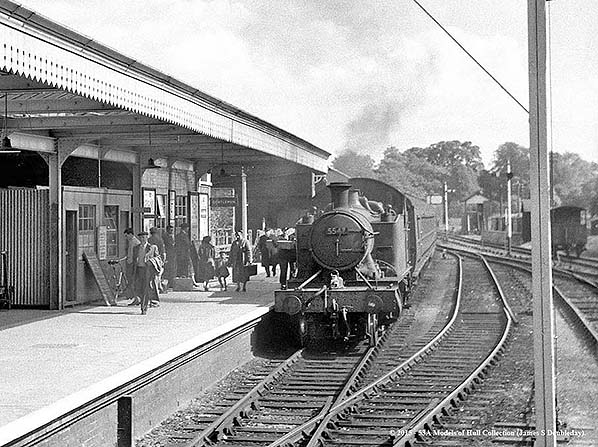 Believed to have been photographed in the summer of 1958, 4575 Class 'Small Prairie' 2-6-2T No. 5547 has just arrived from Kemble with the then usual train comprising a 2-car 'B-set'. A handful of passengers have alighted. Evident on the station are the alterations which had begun in 1956. The station originally had an overall (trainshed) roof, common for GWR termini, replaced by the standard type of canopy seen here in 1874. Behind and left of the train stands the goods shed. This structure replaced the original in 1938 which had a smaller shed, for grain, at its south end. The original goods shed was typical in appearance to the structures one may associate with Brunel's Broad Gauge. In the right background the water tower and signal box can be seen. The signal box dated from 1892 and was a Great Western Railway Type 5 structure. The post in the right foreground supported a loading gauge, the actual gauge spanning the siding on the right which abutted to the end of a dock. Two sidings served the dock, the aforementioned and another serving the dock's west face. The dock was often used for horse traffic. Cirencester also had a cattle pen, visible here behind the nearest signal on the right. The 4575 Class locomotives were a Collett development of the Churchward 4500 Class. No. 5547 was new ex-Swindon Works in October 1928 and survived until February 1962. Eleven of the one hundred strong class have survived into preservation although No. 5547 is not among them.
Believed to have been photographed in the summer of 1958, 4575 Class 'Small Prairie' 2-6-2T No. 5547 has just arrived from Kemble with the then usual train comprising a 2-car 'B-set'. A handful of passengers have alighted. Evident on the station are the alterations which had begun in 1956. The station originally had an overall (trainshed) roof, common for GWR termini, replaced by the standard type of canopy seen here in 1874. Behind and left of the train stands the goods shed. This structure replaced the original in 1938 which had a smaller shed, for grain, at its south end. The original goods shed was typical in appearance to the structures one may associate with Brunel's Broad Gauge. In the right background the water tower and signal box can be seen. The signal box dated from 1892 and was a Great Western Railway Type 5 structure. The post in the right foreground supported a loading gauge, the actual gauge spanning the siding on the right which abutted to the end of a dock. Two sidings served the dock, the aforementioned and another serving the dock's west face. The dock was often used for horse traffic. Cirencester also had a cattle pen, visible here behind the nearest signal on the right. The 4575 Class locomotives were a Collett development of the Churchward 4500 Class. No. 5547 was new ex-Swindon Works in October 1928 and survived until February 1962. Eleven of the one hundred strong class have survived into preservation although No. 5547 is not among them.
Copyright photo
from 53 Models of Hull collection
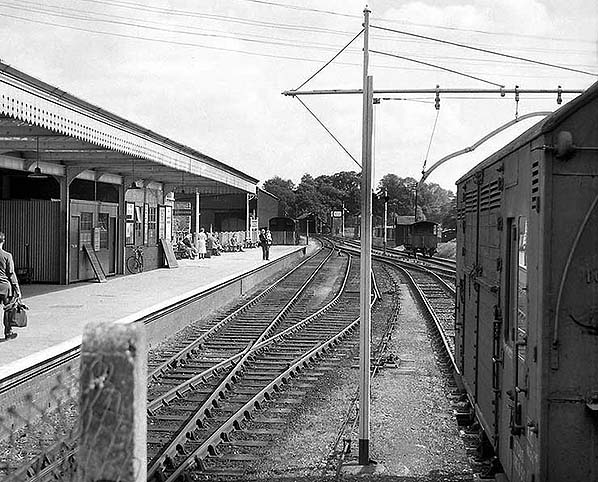 General view of Cirencester Town station, c1958.
General view of Cirencester Town station, c1958.
Copyright photo
from 53 Models of Hull collection
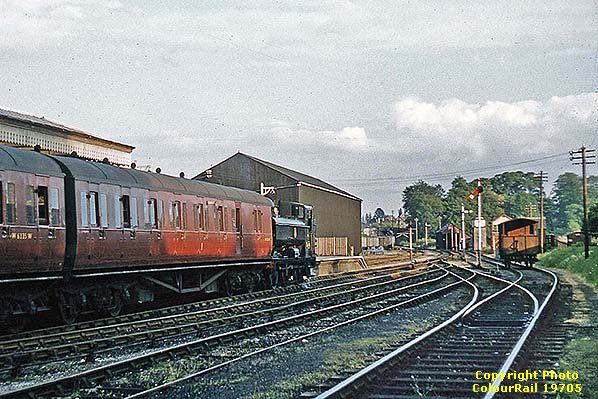 On 10 July 1958 the camera caught 5700 Class 0-6-0PT No. 9720 outside Cirencester's engine shed. In the absence of other information accompanying the photograph, one can only conclude the locomotive is on-shed during a pause in passenger services and that another train is present as implied by the signal being 'off'. In 1874, the station lost its overall roof (trainshed) and the engine shed was rebuilt to the form seen here. In this form it was basic wooden structure on a brick base with a brick office, visible here, on its east side. Ventilation appears to have been very poor. The sign with red and white squares on the end of the shed is a Limited Clearance warning. These signs are still in use today. The wooden hut on the right is thought to have been a packer's shed, 'Packer' being an obsolete term for a Permanent Way Engineer. Between the hut and the engine shed is the locomotive coaling stage; the large lumps of coal will be broken down before use. At far right part of the water tower can be seen. While the tank is instantly recognisable as being of GWR origin the tower is rather unusual. More usual for the GWR was either an iron framework supporting the tank or a fully enclosed brick or stone tower. The tracks at far left served the goods shed and sidings. A goods loading gauge can be seen and it was one of two at Cirencester Town. Their purpose was to ensure goods wagons were not loaded to the point where the loads would strike bridges and other over-line structures. The bridge in the background carried Querns Hill over the railway. This was a continuation of Querns Lane, to the left, and into Mount Street, Somerford Road and what was Cemetery Lane to the right. Querns Hill, the road, no longer exists and has been replaced by Sheep Street a little further south. Locomotive No. 9720 was a Swindon machine at this time. New ex-Swindon Works in November 1934, she was withdrawn in November 1961 and scrapped the following year.
On 10 July 1958 the camera caught 5700 Class 0-6-0PT No. 9720 outside Cirencester's engine shed. In the absence of other information accompanying the photograph, one can only conclude the locomotive is on-shed during a pause in passenger services and that another train is present as implied by the signal being 'off'. In 1874, the station lost its overall roof (trainshed) and the engine shed was rebuilt to the form seen here. In this form it was basic wooden structure on a brick base with a brick office, visible here, on its east side. Ventilation appears to have been very poor. The sign with red and white squares on the end of the shed is a Limited Clearance warning. These signs are still in use today. The wooden hut on the right is thought to have been a packer's shed, 'Packer' being an obsolete term for a Permanent Way Engineer. Between the hut and the engine shed is the locomotive coaling stage; the large lumps of coal will be broken down before use. At far right part of the water tower can be seen. While the tank is instantly recognisable as being of GWR origin the tower is rather unusual. More usual for the GWR was either an iron framework supporting the tank or a fully enclosed brick or stone tower. The tracks at far left served the goods shed and sidings. A goods loading gauge can be seen and it was one of two at Cirencester Town. Their purpose was to ensure goods wagons were not loaded to the point where the loads would strike bridges and other over-line structures. The bridge in the background carried Querns Hill over the railway. This was a continuation of Querns Lane, to the left, and into Mount Street, Somerford Road and what was Cemetery Lane to the right. Querns Hill, the road, no longer exists and has been replaced by Sheep Street a little further south. Locomotive No. 9720 was a Swindon machine at this time. New ex-Swindon Works in November 1934, she was withdrawn in November 1961 and scrapped the following year.
Copyright photo ColourRail
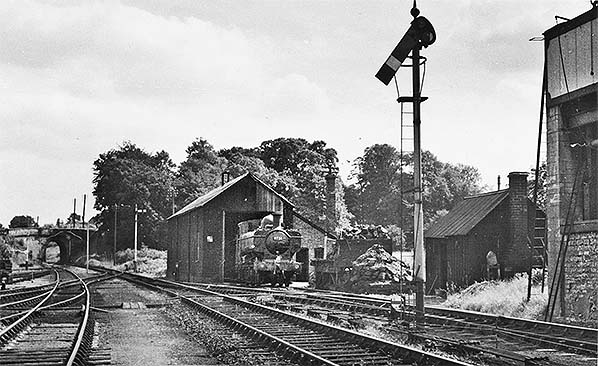 On 10 July 1958 the camera caught 5700 Class 0-6-0PT No. 9720 outside Cirencester's engine shed. In the absence of other information accompanying the photograph, one can only conclude the locomotive is on-shed during a pause in passenger services and that another train is present as implied by the signal being 'off'. In 1874, the station lost its overall roof (trainshed) and the engine shed was rebuilt to the form seen here. In this form it was basic wooden structure on a brick base with a brick office, visible here, on its east side. Ventilation appears to have been very poor. The sign with red and white squares on the end of the shed is a Limited Clearance warning. These signs are still in use today. The wooden hut on the right is thought to have been a packer's shed, 'Packer' being an obsolete term for a Permanent Way Engineer. Between the hut and the engine shed is the locomotive coaling stage; the large lumps of coal will be broken down before use. At far right part of the water tower can be seen. While the tank is instantly recognisable as being of GWR origin the tower is rather unusual. More usual for the GWR was either an iron framework supporting the tank or a fully enclosed brick or stone tower. The tracks at far left served the goods shed and sidings. A goods loading gauge can be seen and it was one of two at Cirencester Town. Their purpose was to ensue goods wagons were not loaded to the point where the loads would strike bridges and other over-line structures. The bridge in the background carried Querns Hill over the railway. This was a continuation of Querns Lane, to the left, and into Mount Street, Somerford Road and what was Cemetery Lane to the right. Querns Hill, the road, no longer exists and has been replaced by Sheep Street a little further south. Locomotive No. 9720 was a Swindon machine at this time. New ex-Swindon Works in November 1934, she was withdrawn in November 1961 and scrapped the following year.
On 10 July 1958 the camera caught 5700 Class 0-6-0PT No. 9720 outside Cirencester's engine shed. In the absence of other information accompanying the photograph, one can only conclude the locomotive is on-shed during a pause in passenger services and that another train is present as implied by the signal being 'off'. In 1874, the station lost its overall roof (trainshed) and the engine shed was rebuilt to the form seen here. In this form it was basic wooden structure on a brick base with a brick office, visible here, on its east side. Ventilation appears to have been very poor. The sign with red and white squares on the end of the shed is a Limited Clearance warning. These signs are still in use today. The wooden hut on the right is thought to have been a packer's shed, 'Packer' being an obsolete term for a Permanent Way Engineer. Between the hut and the engine shed is the locomotive coaling stage; the large lumps of coal will be broken down before use. At far right part of the water tower can be seen. While the tank is instantly recognisable as being of GWR origin the tower is rather unusual. More usual for the GWR was either an iron framework supporting the tank or a fully enclosed brick or stone tower. The tracks at far left served the goods shed and sidings. A goods loading gauge can be seen and it was one of two at Cirencester Town. Their purpose was to ensue goods wagons were not loaded to the point where the loads would strike bridges and other over-line structures. The bridge in the background carried Querns Hill over the railway. This was a continuation of Querns Lane, to the left, and into Mount Street, Somerford Road and what was Cemetery Lane to the right. Querns Hill, the road, no longer exists and has been replaced by Sheep Street a little further south. Locomotive No. 9720 was a Swindon machine at this time. New ex-Swindon Works in November 1934, she was withdrawn in November 1961 and scrapped the following year.
Copyright photo from John Alsop collection
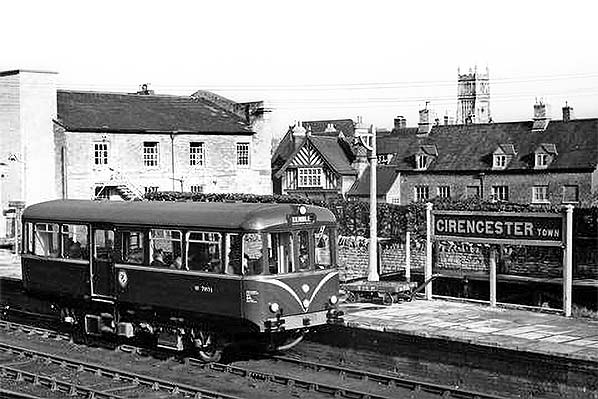 A railbus leaves Cirencester Town for Kemble in February 1959, shortly after the railbus service started. Behind the platform would have been the siding that ran through the goods shed. There appears to be a narrow platform on the far side of the track. This presumably replaced the footpath from the station to the goods shed that is marked on an earlier plan. The buildings from left to right are the Memorial Hospital (the former Independent Chapel), the Cottage Hospital (with half-timbered effect) and buildings on the far side of Sheep Street. The tower of the parish church is visible.
A railbus leaves Cirencester Town for Kemble in February 1959, shortly after the railbus service started. Behind the platform would have been the siding that ran through the goods shed. There appears to be a narrow platform on the far side of the track. This presumably replaced the footpath from the station to the goods shed that is marked on an earlier plan. The buildings from left to right are the Memorial Hospital (the former Independent Chapel), the Cottage Hospital (with half-timbered effect) and buildings on the far side of Sheep Street. The tower of the parish church is visible.
Photo
from John Mann collection
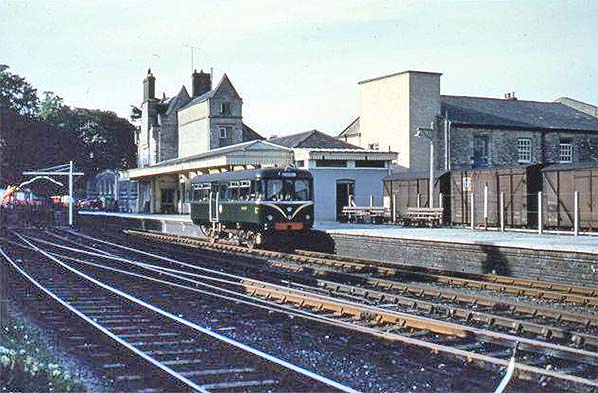 On an unknown date an AC Cars diesel railbus starts out on its short journey to Kemble but still displaying 'Cirencester Town' on its destination blind. The number of the railbus is unclear but is thought to be W79977. Its smart condition suggests it is brand new, in which case the date will be sometime in 1959. Railbuses had been introduced to the Tetbury and Cirencester branches in February of that year. This view is somewhat unusual as the majority of photographs from railbus days show the vehicle stationary at the far end of the platform. Electric platform lighting has now replaced the gas lighting. The vans behind the platform are on the siding which ran through the goods shed. The building in the right background, now with tower added and which presumably contains a staircase and lift, is the Apsley Memorial Hall. Opened as such in 1921, it commemorates Cirencester's dead of World War One. The building was originally an annex to the hospital which had stood on the opposite side of Sheep Street and which was demolished in the early 21st century. The Memorial Hall still stands in 2021.
On an unknown date an AC Cars diesel railbus starts out on its short journey to Kemble but still displaying 'Cirencester Town' on its destination blind. The number of the railbus is unclear but is thought to be W79977. Its smart condition suggests it is brand new, in which case the date will be sometime in 1959. Railbuses had been introduced to the Tetbury and Cirencester branches in February of that year. This view is somewhat unusual as the majority of photographs from railbus days show the vehicle stationary at the far end of the platform. Electric platform lighting has now replaced the gas lighting. The vans behind the platform are on the siding which ran through the goods shed. The building in the right background, now with tower added and which presumably contains a staircase and lift, is the Apsley Memorial Hall. Opened as such in 1921, it commemorates Cirencester's dead of World War One. The building was originally an annex to the hospital which had stood on the opposite side of Sheep Street and which was demolished in the early 21st century. The Memorial Hall still stands in 2021.
Photo
from Derek King collection
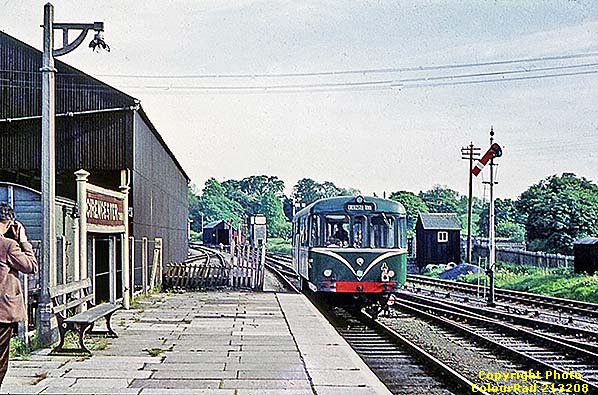 An AC Cars railbus leaves Cirencester Town for Kemble on 13 May 1961. A goods van, partly in the goods shed, can be seen to the left, behind the 1956 electric lighting. This is the later goods shed with only one track through it. The second track through the original goods shed is now a siding between the shed and the running line.
An AC Cars railbus leaves Cirencester Town for Kemble on 13 May 1961. A goods van, partly in the goods shed, can be seen to the left, behind the 1956 electric lighting. This is the later goods shed with only one track through it. The second track through the original goods shed is now a siding between the shed and the running line.
Copyright photo ColourRail
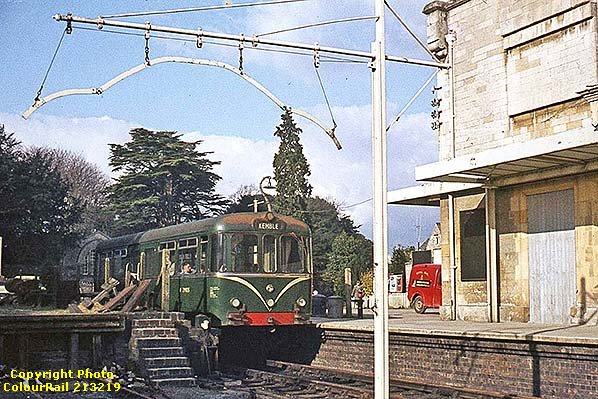 On Saturday 20 May 1961 AC Cars diesel railbus No. W79975 awaits departure with a few passengers on board. Despite the station platform having a canopy it was normal practice for railbuses to draw up at the very end of the line, in open air. This is thought to have been for the convenience of loading and unloading mail. A Royal Mail Morris 1000 van can be seen and many photographs show a Royal Mail vehicle to be present. Unlike today, at one time there were several deliveries of mail each weekday. The station shows evidence of the 1956 modernisation which was abruptly halted the following year, presumably as a result of a review of spending on branch lines. In more recent times the doorway seen here boarded-up has been reinstated but with modern uPVC fittings. This photograph offers a good view of the GWR goods loading gauge with its hinged outer sections, the purpose of which was to suit the differing loading restrictions of the GWR and other companies’ systems, in particular the LMS. Cirencester Town had two of these loading gauges, the other being located in sidings at the Kemble end of the station. On the left, the goods dock presents a rather ramshackle appearance. It was provided with end loading in the usual manner as seen here, plus another siding serving its west face, out of view to the left. The chapel-like building behind the railbus and to the left was the Corinium Museum. This was provided by the 4th Earl of Bathurst and opened in 1856. The museum has since relocated to Park Street and as of December 2021 the original building is occupied by a software company. Of the five AC Cars railbuses, one went new to the Scottish Region with the other four going to the Western Region. Ultimately all ended up in Scotland with No. W79978, never having been given the 'SC' prefix, going on to be the final passenger railbus in BR service, being withdrawn on 29 January 1968. No. W79978 then entered preservation, running under its own power to the then-fledgling North Yorkshire Moors Railway. One other of the type, No. 79976. also entered preservation. No. 79975 was not so lucky, being scrapped by T.W. Ward at Inverkeithing during August 1968.
On Saturday 20 May 1961 AC Cars diesel railbus No. W79975 awaits departure with a few passengers on board. Despite the station platform having a canopy it was normal practice for railbuses to draw up at the very end of the line, in open air. This is thought to have been for the convenience of loading and unloading mail. A Royal Mail Morris 1000 van can be seen and many photographs show a Royal Mail vehicle to be present. Unlike today, at one time there were several deliveries of mail each weekday. The station shows evidence of the 1956 modernisation which was abruptly halted the following year, presumably as a result of a review of spending on branch lines. In more recent times the doorway seen here boarded-up has been reinstated but with modern uPVC fittings. This photograph offers a good view of the GWR goods loading gauge with its hinged outer sections, the purpose of which was to suit the differing loading restrictions of the GWR and other companies’ systems, in particular the LMS. Cirencester Town had two of these loading gauges, the other being located in sidings at the Kemble end of the station. On the left, the goods dock presents a rather ramshackle appearance. It was provided with end loading in the usual manner as seen here, plus another siding serving its west face, out of view to the left. The chapel-like building behind the railbus and to the left was the Corinium Museum. This was provided by the 4th Earl of Bathurst and opened in 1856. The museum has since relocated to Park Street and as of December 2021 the original building is occupied by a software company. Of the five AC Cars railbuses, one went new to the Scottish Region with the other four going to the Western Region. Ultimately all ended up in Scotland with No. W79978, never having been given the 'SC' prefix, going on to be the final passenger railbus in BR service, being withdrawn on 29 January 1968. No. W79978 then entered preservation, running under its own power to the then-fledgling North Yorkshire Moors Railway. One other of the type, No. 79976. also entered preservation. No. 79975 was not so lucky, being scrapped by T.W. Ward at Inverkeithing during August 1968.
Copyright photo ColourRail
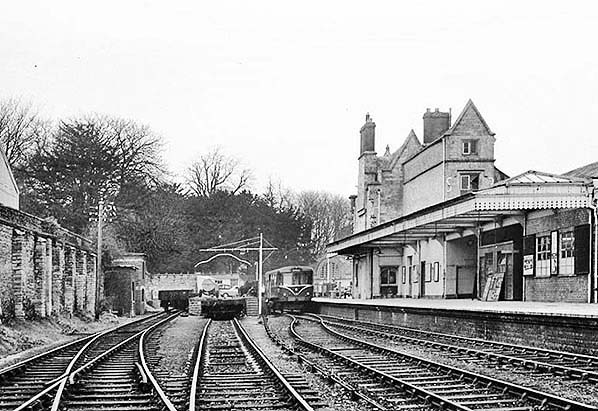 On an unknown date an AC Cars diesel railbus stands at the usual location at the far end of the platform. The station can be seen in its modernised, if somewhat clinical, form. Just visible on the end wall above the canopy are tie-bars with 'S' shaped terminations. These were used to arrest outward bulging of external walls and remain a common sight today including those seen in this view. The wall on the left is a remnant of the time when the station had an overall roof. It still stands as of 2021, extending down to Tetbury Road. Three brick huts were provided against the wall and are visible here. One was a porter's hut and another was an oil store but the purpose of the third remained unclear at the time of writing. A flat wagon stands at the dock, just beyond the loading gauge, with another wagon on the siding serving the west face of the dock. This latter siding also extended as far as Tetbury Road. The 1956 modernisation of the station, which was abruptly halted while incomplete, was done at a time when trains were still steam hauled. The introduction of railbuses in 1959, with their habit of waiting at the canopy-less extremity of the platform, made the modernisation somewhat superfluous.
On an unknown date an AC Cars diesel railbus stands at the usual location at the far end of the platform. The station can be seen in its modernised, if somewhat clinical, form. Just visible on the end wall above the canopy are tie-bars with 'S' shaped terminations. These were used to arrest outward bulging of external walls and remain a common sight today including those seen in this view. The wall on the left is a remnant of the time when the station had an overall roof. It still stands as of 2021, extending down to Tetbury Road. Three brick huts were provided against the wall and are visible here. One was a porter's hut and another was an oil store but the purpose of the third remained unclear at the time of writing. A flat wagon stands at the dock, just beyond the loading gauge, with another wagon on the siding serving the west face of the dock. This latter siding also extended as far as Tetbury Road. The 1956 modernisation of the station, which was abruptly halted while incomplete, was done at a time when trains were still steam hauled. The introduction of railbuses in 1959, with their habit of waiting at the canopy-less extremity of the platform, made the modernisation somewhat superfluous.
Photo
from Derek King collection
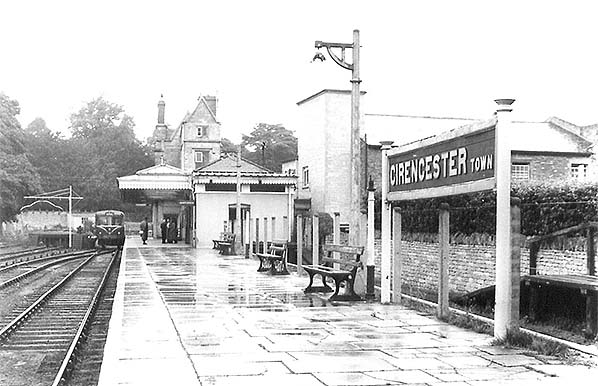 A view along platform to buffer stops during railbus era, 1959-64.
A view along platform to buffer stops during railbus era, 1959-64.
Photo
from John Mann collection
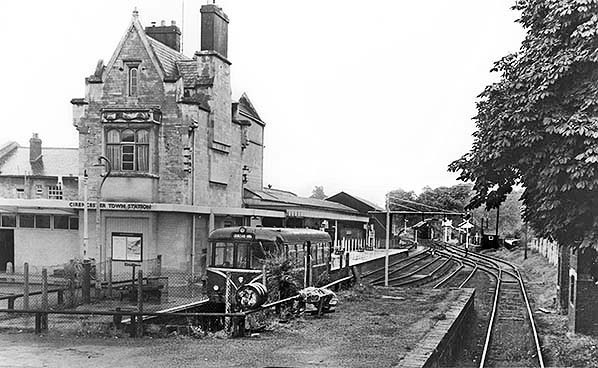 A view from the right hand side of station forecourt during the railbus era, 1956-64. Removal of the timber fence round platform ends means that the platform is visible and the railbus has stopped close to the buffer stops.
A view from the right hand side of station forecourt during the railbus era, 1956-64. Removal of the timber fence round platform ends means that the platform is visible and the railbus has stopped close to the buffer stops.
Photo
from John Mann collection
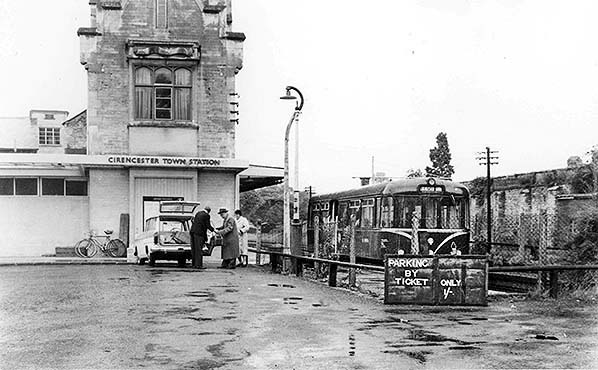 A view from the centre of the station forecourt 1959-64 with the railbus in use.
A view from the centre of the station forecourt 1959-64 with the railbus in use.
Photo
from John Mann collection
Click here for Cirencester Town Gallery 4:
c1960 - c 1973

